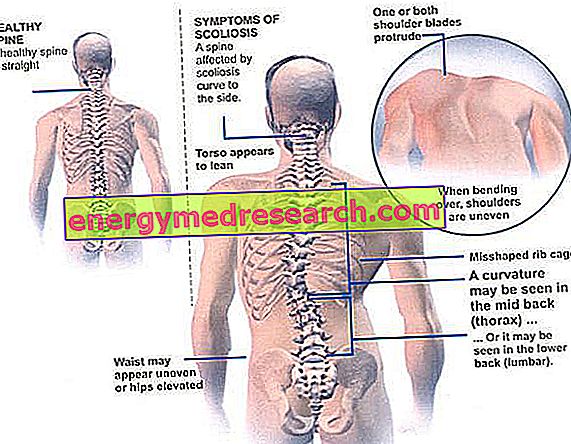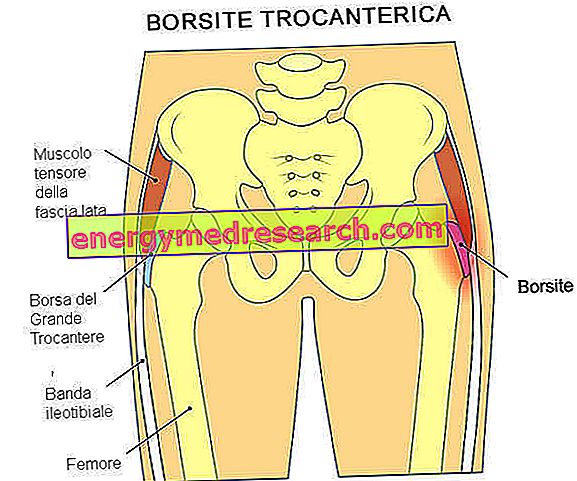By Dr. Giovanni Chetta Diagnosis of scoliosis Scoliosis is frequently identified by its aesthetic evidence or by instrumental examinations (radiographs, magnetic resonances, etc.) performed for other reasons. Some signs that can give rise to the suspicion of a scoliotic presence are: Clear inequality of the two triangles of size; A shoulder considerably higher than the contralateral; Clear inclination (and rotation) of the pelvis; A shoulder blade definitely more prominent than the other; Clear inclination of the head and / or the whole body on one side; Clear diversity in the right foot suppor
Category traumatology
Generality Trochanteric bursitis is an inflammatory disease that affects one or more synovial bursa of the proximal femoral epiphysis. It has mainly mechanical (functional or traumatic) causes and causes pain in the affected site, even in association with swelling and redness. To prevent it from getting worse or chronic, it is important to consult a doctor, who will prescribe drug therapy and physiotherapy; surgery is almost never necessary
What is that What does kinesitherapy mean? Kinesiotherapy (kinesiotherapy or kinesiatry) is a noun that derives from the union of the two Greek words "kinésis" (movement) and "therapeía" (cure or remedy); literally means "method of care through movement". Kinesiotherapy is therefore therapy through movement; on the other hand, there are various systems, methods and levels of work: this is why this term is to be considered at least "ambiguous".
By Dr. Dario Mirra Introduction Every sport has particular needs from a technical, coordinative and conditional point of view, hence, as a direct consequence, injuries are statistically peculiar for each sporting activity. What I will discuss in this article is a reflection, a simple opinion to prevent injuries to the inner thigh muscles, disabling discomfort typical of sporting activities that require movements with sudden changes of direction and speed (for example Rugby), lateral movements (Tennis) and again activities in which these muscles are in constant tension (Equitazione)
Key points The term cervicalgia defines a generic pain in the neck that lasts for a variable period of time (months / years). It is an extremely widespread musculoskeletal disorder among the population. Causes Cervicalgia can be triggered by a set of particularly numerous and heterogeneous causes. Among all, a sedentary lifestyle, strokes of cold and incorrect posture are the most involved etiopathological elements
Generality Cervicobrachialgia is a medical condition caused by the compression of nerve structures connected to the spinal nerves C5, C6, C7 and C8, which mainly causes pain in the neck and pain in one or both upper limbs (including shoulders and hands). Also known as cervico-brachial syndrome , cervicobrachialgia most frequently affects people who perform manual activities where certain gestures or movements are repeated continuously
Key points Ecchymosis is an extravasation of blood in a tissue, the result of a blunt trauma able to damage the walls of blood vessels, without interrupting the integuments. Ecchymosis: causes The most frequent ecchymoses are induced by traumas or minor-to-moderate contusions. In addition to these elements, ecchymoses may result in alterations in blood coagulation (hemophilia, leukemia, thrombocytopenia), some diseases (phlebitis, lupus, scurvy) and anticoagulant therapies
SIMILARITIES Both hematoma and ecchymosis identify extravasation of blood concentrated outside the blood vessels, an expression of trauma capable of breaking the vessel walls, without injuring the skin Both hematoma and ecchymosis are induced by trauma, bumps or bruises Both bruises can be favored by alterations in the coagulation capacity of the blood (leukemia, thrombocytopenia, hemophilia) and by anticoagulant therapies The lesions modulate the color scheme with the passage of time: the hematomas and ecchymoses, at first red, become blue / violet, then green and, finally, yellow They can be
The ideal treatment for hematomas depends on the severity of the trauma suffered - or on the severity of the underlying condition - and on the location involved. Hematomas: definition and causes As we know, the hematoma is a collection of blood in a tissue or organ, accumulated following the rupture of a blood vessel, either a capillary or any other duct of the circulatory system
Key points The hematoma is a collection of blood located outside the blood vessels, a typical consequence of trauma or bruising. Blood flows out of the circulation, concentrates in a tissue or in a cavity of the organism, and gives rise to a hematoma. Hematoma: causes In addition to traumas and bruises, the hematoma can also be caused by other factors: alteration of coagulation (thrombocytopenia, hemophilia), surgical wounds, leukemia, anticoagulant therapy (heparin, dicumarol, etc
There are multiple variants of hematoma, classified essentially on the basis of the severity and location of the trauma suffered. Hematoma: symptoms More often, the hematoma is the expression of a blunt trauma that, while not causing cutaneous wounds, damages a blood vessel: inevitably, in similar circumstances, the blood spills from the blood vessel to the surrounding tissue, accumulating and creating a bruise, known as hematoma










